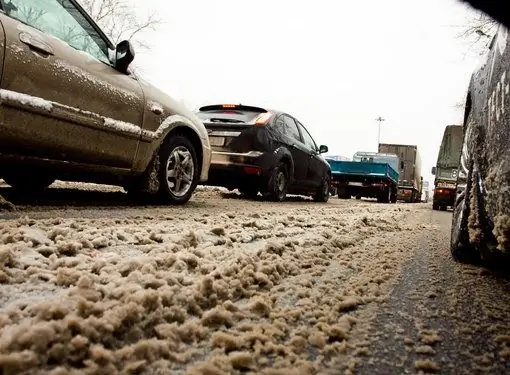- Author Nora Macey [email protected].
- Public 2023-12-16 10:17.
- Last modified 2025-01-23 08:48.
The SBG reagent was used in 2004-2007 as an anti-icing agent on Moscow roads. It turned out to be extremely ineffective and dangerous - its radioactive background was several times higher than the natural one.

The SBG reagent was previously used to combat icy roads. This abbreviation stands for "anti-icing agent".
UBG as a means to combat citizens
A big scandal was connected with the use of SBG. In 2004-2006, the Moscow mayor's office purchased about 80 tons of SBG reagent. But the public did not allow the use of "chemistry" on the roads. It turned out that SBG is a waste from the production of potash fertilizers. Partly the reagent consists of a black precipitate insoluble in water, and partly of potassium salts. The main danger lies in the fact that SBG contains a lot of potassium-40 - a radioactive isotope of potassium with a half-life of a billion years. Although this substance is found almost everywhere - from food products to drinking water, its concentration in the SBG was overestimated to such an extent that the reagent "phonil". Its radioactive background was two to four times higher than the natural background.
The use of SBG on Moscow streets turned out to be completely unjustified - the reagent did not dissolve well and led to the appearance of sticky black mud on the roads, which was dangerous for people and cars. Just a few seasons of driving on roads generously "fertilized" by the SBG could render the body of any car unusable.
Refusal to use SBG
After a series of additional examinations, the Moscow mayor's office decided to return the low-quality reagent to the manufacturer. It turned out that the SBG began to "work" only under the condition of heavy traffic on the roads and, among other things, contained in its composition the salts of heavy metals hazardous to health - cadmium, zinc, lead.
In 2007, the use of SBG in the capital was completely banned. Reagent stocks accumulated in warehouses in Moscow were arrested. The Moscow government has filed a number of lawsuits against the manufacturer of SBG - SBG-Trading. Unfortunately, the manufacturer of the hazardous substance managed to fight back on all charges in the arbitration courts.
Modern reagents
Now, anti-ice reagents are used to combat ice on the roads, which should contain no more than 2% of water-insoluble compounds. They should have an acidity index of 5 to 9 and a specific effective activity of radionuclides not higher than 370 becquerels per kg. Such substances include reagents KhKNM (Modified Sodium Calcium Chloride), "Bishofit", "Ecosol", etc.






